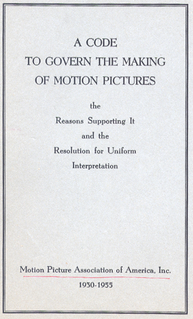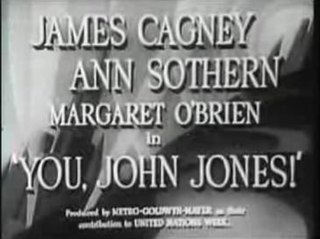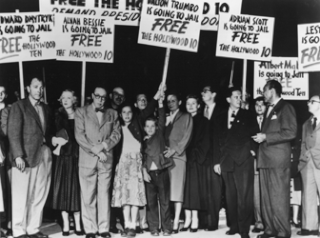
The cinema of the Soviet Union includes films produced by the constituent republics of the Soviet Union reflecting elements of their pre-Soviet culture, language and history, albeit they were all regulated by the central government in Moscow. Most prolific in their republican films, after the Russian Soviet Federative Socialist Republic, were Armenia, Azerbaijan, Georgia, Ukraine, and, to a lesser degree, Lithuania, Belarus and Moldavia. At the same time, the nation's film industry, which was fully nationalized throughout most of the country's history, was guided by philosophies and laws propounded by the monopoly Soviet Communist Party which introduced a new view on the cinema, socialist realism, which was different from the one before or after the existence of the Soviet Union.
The Society of Motion Picture and Television Engineers (SMPTE), founded in 1916 as the Society of Motion Picture Engineers or SMPE, is a global professional association of engineers, technologists, and executives working in the media and entertainment industry. As an internationally recognized standards organization, SMPTE has published more than 800 technical standards and related documents for broadcast, filmmaking, digital cinema, audio recording, information technology (IT), and medical imaging.

The Motion Picture Production Code was a set of industry guidelines for the self-censorship of content that was applied to most motion pictures released by major studios in the United States from 1934 to 1968. It is also popularly known as the Hays Code, after Will H. Hays, president of the Motion Picture Producers and Distributors of America (MPPDA) from 1922 to 1945. Under Hays's leadership, the MPPDA, later the Motion Picture Association of America (MPAA) and the Motion Picture Association (MPA), adopted the Production Code in 1930 and began rigidly enforcing it in 1934. The Production Code spelled out acceptable and unacceptable content for motion pictures produced for a public audience in the United States.

The cinema of Taiwan is deeply rooted in the island's unique history. Since its introduction to Taiwan in 1901 under Japanese rule, cinema has developed in Taiwan under ROC rule through several distinct stages. It has also developed outside the Hong Kong mainstream and the censorship of the People's Republic of China in the mainland.
A trade association, also known as an industry trade group, business association, sector association or industry body, is an organization founded and funded by businesses that operate in a specific industry. An industry trade association participates in public relations activities such as advertising, education, publishing, lobbying, and political donations, but its focus is collaboration between companies. Associations may offer other services, such as producing conferences, holding networking or charitable events, or offering classes or educational materials. Many associations are non-profit organizations governed by bylaws and directed by officers who are also members.

The Shaggy Dog is a 1959 American comedy film produced by Walt Disney Productions and loosely based on the 1923 novel The Hound of Florence by Felix Salten. Directed by Charles Barton from a screenplay by Lillie Hayward and Bill Walsh, the film stars Fred MacMurray, Tommy Kirk, Jean Hagen, Kevin Corcoran, Tim Considine, Roberta Shore, and Annette Funicello. The film follows a teenage boy named Wilby Daniels who, by the power of an enchanted ring of the Borgias, is transformed into a shaggy Old English Sheepdog.
UFA GmbH, shortened to UFA, is a film and television production company that unites all production activities of the media conglomerate Bertelsmann in Germany. Its name derives from Universum-Film Aktiengesellschaft, a major German film company headquartered in Babelsberg, producing and distributing motion pictures from 1917 until the end of the Nazi era. The name UFA was revived by Bertelsmann for an otherwise unrelated film and television outfit, UFA GmbH.
The Cinema of the Russian Empire roughly spans the period 1907 - 1920, during which time a strong infrastructure was created. From the over 2,700 art films created in Russia before 1920, around 300 remain to this day.

The United States Office of War Information (OWI) was a United States government agency created during World War II. The OWI operated from June 1942 until September 1945. Through radio broadcasts, newspapers, posters, photographs, films and other forms of media, the OWI was the connection between the battlefront and civilian communities. The office also established several overseas branches, which launched a large-scale information and propaganda campaign abroad. From 1942 to 1945, the OWI revised or discarded any film scripts reviewed by them that portrayed the United States in a negative light, including anti-war material.
Eric Allen Johnston was a business owner, president of the United States Chamber of Commerce, a Republican Party activist, president of the Motion Picture Association of America (MPAA), and a U.S. government special projects administrator and envoy for both Democratic and Republican administrations. As president of the MPAA, he abbreviated the organization's name, convened the closed-door meeting of motion picture company executives at New York City's Waldorf-Astoria Hotel that led to Waldorf Statement in 1947 and the Hollywood blacklist, and discreetly liberalized the Motion Picture Production Code. He served as president of the MPAA until his death in 1963.

Japanese Relocation is a 1942 short film produced by the U.S. Office of War Information and distributed by the War Activities Committee of the Motion Picture Industry. It is a propaganda film, justifying and explaining Japanese American internment on the West Coast during World War II. It is narrated by Milton Eisenhower.

George Glass was an American film producer and publicist, best known for his work with Stanley Kramer. In Kramer's 1997 autobiography, describing how he formed his first production company in the late 1940s, he called Glass "one of the best publicity men in town", and remarked "I was fortunate to get Glass, with whom I had worked in the Lewin-Loew partnership before the war. He was a bright man and a very smooth operator." In a 1973 biography of Marlon Brando, Bob Thomas wrote:
George Glass was a veteran of movie publicity, but he was more than a publicist for Kramer. He, Kramer and Carl Foreman were partners in the independent film company, and Glass's brilliant campaigns for Champion and Home of the Brave had been a major part of the company's success. A short, stubby, ebullient man, he performed his craft on the basis of telling the truth.

You, John Jones! (1943) is a short film directed by Mervyn LeRoy, written by Carey Wilson, and released by Metro-Goldwyn-Mayer, and starring James Cagney, Ann Sothern, and Margaret O'Brien. The film credits the War Activities Committee of the Motion Picture Industry for its production. The title frame also says "Produced by Metro-Goldwyn-Mayer as their contribution to United Nations Week".
A film – also called a movie, motion picture, moving picture, picture or photoplay – is a work of visual art that simulates experiences and otherwise communicates ideas, stories, perceptions, feelings, beauty, or atmosphere through the use of moving images. These images are generally accompanied by sound and, more rarely, other sensory stimulations. The word "cinema", short for cinematography, is often used to refer to filmmaking and the film industry, and to the art form that is the result of it.

The so-called Hollywood blacklist was an entertainment industry blacklist, broader than just Hollywood, put in effect in the mid-20th century in the United States during the early years of the Cold War. The blacklist involved the practice of denying employment to entertainment industry professionals believed to be or to have been Communists or sympathizers. Not just actors, but screenwriters, directors, musicians, and other American entertainment professionals were barred from work by the studios. This was usually done on the basis of their membership in, alleged membership in, or sympathy with the Communist Party USA, or on the basis of their refusal to assist Congressional investigations into the party's activities. Even during the period of its strictest enforcement, from the late 1940s through to the late 1950s, the blacklist was rarely made explicit or easily verifiable, as it was the result of numerous individual decisions by the studios and was not the result of official legal action. Nevertheless, it quickly and directly damaged or ended the careers and income of scores of individuals working in the film industry.

The House Committee on Un-American Activities (HCUA), popularly dubbed the House Un-American Activities Committee (HUAC), was an investigative committee of the United States House of Representatives, created in 1938 to investigate alleged disloyalty and subversive activities on the part of private citizens, public employees, and those organizations suspected of having either fascist or communist ties. It became a standing (permanent) committee in 1945, and from 1969 onwards it was known as the House Committee on Internal Security. When the House abolished the committee in 1975, its functions were transferred to the House Judiciary Committee.
The Return of the Shaggy Dog is a 1987 American two-part made-for-television comedy film produced by Walt Disney Television. The film is set in the 17 years between the events portrayed in The Shaggy Dog (1959) and The Shaggy D.A. (1976). It was broadcast on November 1 and 8, 1987 as a Disney Sunday Movie presentation on ABC.
Food and Magic is a 1943 short documentary film commissioned by the United States Government during World War II. Food and Magic, was produced by the War Activities Committee of The Motion Picture Industry and it deals with food conservation and healthy eating. It stars Jack Carson as a sideshow barker who informs the crowd about proper wartime food consumption, including conservation and rationing.
The Senate Investigation into Motion Picture War Propaganda was a 1941 investigation by a group of isolationist United States Senators which set out to find evidence that the United States movie industry was agitating for the United States to join World War II on the side of the Allies.










